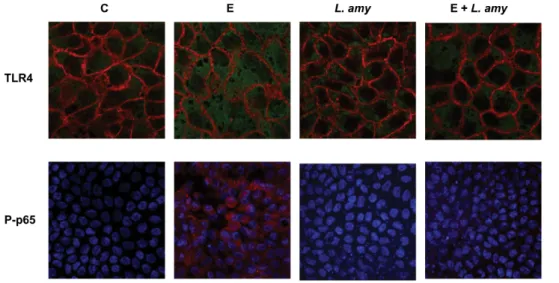Lactobacillus amylovorus Inhibits the TLR4 Inflammatory Signaling Triggered by Enterotoxigenic Escherichia coli via Modulation of the Negative Regulators and Involvement of TLR2 in Intestinal Caco-2 Cells and Pig Explants
Texte intégral
Figure


Documents relatifs
❚ ❚ The results indicate that citrus flavanones enhance the carotenoid uptake by intestinal cells and that addition of ascorbic acid counteract this effect. We supposed that HES-G has
As a consequence of the changes, described earlier, in bile acid availability in the lumen of the intestines, the amount of dietary cholesterol absorbed was about 9 mg/mouse per
We used overlapping peptide assays to map the APN-FaeG binding sites, which has facilitated in the identifying the APN-binding amino acids that are located in the same region of
postlaparotomy ileus: a total suppression of myo- electric activity, followed by a period of unorganised spiking activity.2 In our experiments the first period was shortened
(C) Hep3B hepatoma cells, (D) non-neoplastic PH5CH8 liver cells, (E) A549 lung adenocarcinoma cells, (F) DU145 prostate cancer cells, (G) HEK293T cells, and (H) IGR39 melanoma
On the one hand, assuming that the burst- ing of the film results in an exponential decrease of the pressure in the output plane with the characteristic time τ , one can estimate
ٍضُئزنا ببضنا ٍه ذُملاتهن ةدوذحمنا ثادزفمنا نأ تُناحنا تصارذنا عزتفت دذظنا اذه ٍف ٍمهعتمن ثادزفمنا مُهعت تُمهأ راهظإ لواحت كنذن اقفو و تَزُهجولإا تغهنا
Using the Medical Information Mart for Inten- sive Care-III (MIMIC-III) a critical care database that was developed and maintained by the Laboratory for Computational Physiology